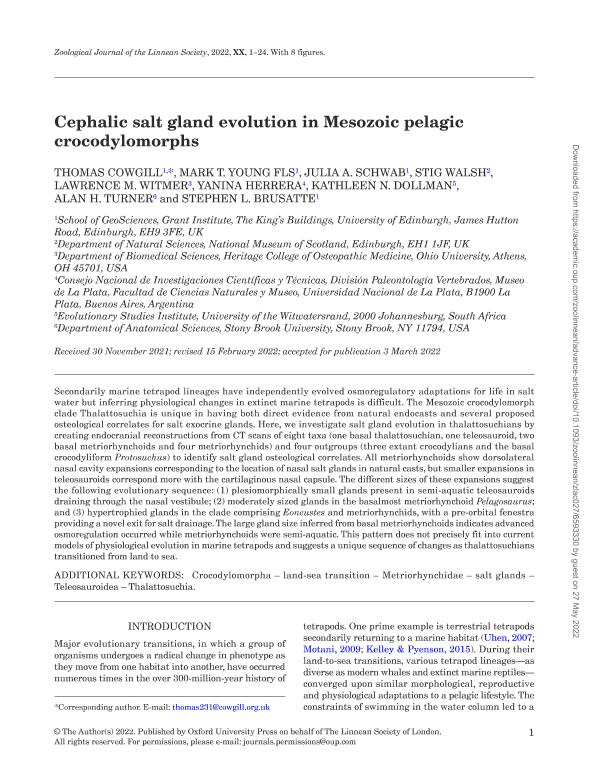Artículo
Cephalic salt gland evolution in Mesozoic pelagic crocodylomorphs
Cowgill, T.; Young, M.; Schwab, J.; Walsh, S.; Witmer, Lawrence; Herrera, Laura Yanina ; Dollman, K.; Turner, A. H.; Brusatte, S.
; Dollman, K.; Turner, A. H.; Brusatte, S.
 ; Dollman, K.; Turner, A. H.; Brusatte, S.
; Dollman, K.; Turner, A. H.; Brusatte, S.
Fecha de publicación:
05/2022
Editorial:
Wiley Blackwell Publishing, Inc
Revista:
Zoological Journal of the Linnean Society
ISSN:
0024-4082
Idioma:
Inglés
Tipo de recurso:
Artículo publicado
Clasificación temática:
Resumen
Secondarily marine tetrapod lineages have independently evolved osmoregulatory adaptations for life in salt water but inferring physiological changes in extinct marine tetrapods is difficult. The Mesozoic crocodylomorph clade Thalattosuchia is unique in having both direct evidence from natural endocasts and several proposed osteological correlates for salt exocrine glands. Here, we investigate salt gland evolution in thalattosuchians by creating endocranial reconstructions from CT scans of eight taxa (one basal thalattosuchian, one teleosauroid, two basal metriorhynchoids and four metriorhynchids) and four outgroups (three extant crocodylians and the basal crocodyliform Protosuchus) to identify salt gland osteological correlates. All metriorhynchoids show dorsolateral nasal cavity expansions corresponding to the location of nasal salt glands in natural casts, but smaller expansions in teleosauroids correspond more with the cartilaginous nasal capsule. The different sizes of these expansions suggest the following evolutionary sequence: (1) plesiomorphically small glands present in semi-aquatic teleosauroids draining through the nasal vestibule; (2) moderately sized glands in the basalmost metriorhynchoid Pelagosaurus; and (3) hypertrophied glands in the clade comprising Eoneustes and metriorhynchids, with a pre-orbital fenestra providing a novel exit for salt drainage. The large gland size inferred from basal metriorhynchoids indicates advanced osmoregulation occurred while metriorhynchoids were semi-aquatic. This pattern does not precisely fit into current models of physiological evolution in marine tetrapods and suggests a unique sequence of changes as thalattosuchians transitioned from land to sea.
Archivos asociados
Licencia
Identificadores
Colecciones
Articulos(CCT - LA PLATA)
Articulos de CTRO.CIENTIFICO TECNOL.CONICET - LA PLATA
Articulos de CTRO.CIENTIFICO TECNOL.CONICET - LA PLATA
Citación
Cowgill, T.; Young, M.; Schwab, J.; Walsh, S.; Witmer, Lawrence; et al.; Cephalic salt gland evolution in Mesozoic pelagic crocodylomorphs; Wiley Blackwell Publishing, Inc; Zoological Journal of the Linnean Society; 5-2022; 1-24
Compartir
Altmétricas



